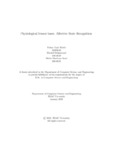| dc.contributor.advisor | Alam, Md. Golam Rabiul | |
| dc.contributor.author | Habib, Fahim Fazle | |
| dc.contributor.author | Mohammad, Khaled | |
| dc.contributor.author | Sami, Sikder Shadman | |
| dc.date.accessioned | 2021-10-21T05:01:07Z | |
| dc.date.available | 2021-10-21T05:01:07Z | |
| dc.date.copyright | 2021 | |
| dc.date.issued | 2021-01 | |
| dc.identifier.other | ID 16201048 | |
| dc.identifier.other | ID 19141028 | |
| dc.identifier.other | ID 20141031 | |
| dc.identifier.uri | http://hdl.handle.net/10361/15505 | |
| dc.description | This thesis is submitted in partial fulfillment of the requirements for the degree of Bachelor of Science in Computer Science and Engineering, 2021. | en_US |
| dc.description | Cataloged from PDF version of thesis. | |
| dc.description | Includes bibliographical references (pages 32-33). | |
| dc.description.abstract | With rapid advancements of Medical IoT sensors in recent years, using them to
recognize an individual’s affective state has become more easily attainable. If an
individual’s physiological signals are recorded while they are made to experience
certain feelings, the data can be used to create a model that can recognize those
feelings using the sensor data. In this paper, a system is created to use data collected
from physiological sensors to predict the affective state of the individual the data is
extracted from. First, the sensor data was trimmed down to just the portions where
the participants experience the feeling and filtered to get rid of unnecessary features
and bad data. Then, the data was processed to condense the sensor readings of the
entire time a user experienced a feeling into a single row that represents that time
period. Finally, the data was mapped to the feeling felt. Instead of using generic
colloquial terms for emotions, more abstract notions of defining emotions were used
- specifically, the Valence-Arousal-Dominance space which defines emotions using
these three parameters. Using that data-set, feature selection was done to find
the most important features to feed to Machine Learning Models to detect the
affective state of the patient in the Valence-Arousal-Dominance space. The novelty
of our research comes from the features used to predict the emotions, which include
statistical representations of the raw signal data and special domain features that
give further insight into the signal data from EEG and ECG. | en_US |
| dc.description.statementofresponsibility | Fahim Fazle Habib | |
| dc.description.statementofresponsibility | Khaled Mohammad | |
| dc.description.statementofresponsibility | Sikder Shadman Sami | |
| dc.format.extent | 33 pages | |
| dc.language.iso | en | en_US |
| dc.publisher | Brac University | en_US |
| dc.rights | Brac University theses are protected by copyright. They may be viewed from this source for any purpose, but reproduction or distribution in any format is prohibited without written permission. | |
| dc.subject.lcsh | Physiology | |
| dc.title | Physiological sensor based affective state recognition | en_US |
| dc.type | Thesis | en_US |
| dc.contributor.department | Department of Computer Science and Engineering, Brac University | |
| dc.description.degree | B. Computer Science | |

